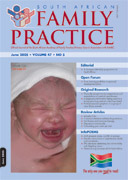Is pregnancy termination being used as a family planning method in the Free State?
Abstract
Background: This study determined the profile of women seeking termination of pregnancy (TOP) in the Free State and whether TOP was used as a family planning method. Methods: Seven hundred and fifty women (15-47 years old) seeking TOP at the Reproductive Health Unit of the National Hospital in Bloemfontein were included in this cross-sectional study. The women who gave verbal consent completed a questionnaire during counselling. Results: The median age of the participants was 24 years and 77.3% were single. Most participants (73.3%) were not using any family planning method at the time of the study. One-fifth (19.1%) had previously had at least one TOP, while for 80.9% of the participants it was their first visit. Some participants (16.6%) considered TOP a family planning method, 39.7% were unsure and 43.7% indicated that TOP is not a family planning method. Thirty-nine women failed to answer this question. When asked the reason for TOP, 3.5% chose the option “contraceptive method. Conclusions: The relatively high percentage of participants who consider TOP a contraceptive method or are unsure, associated with the fact that most were young, single, not using contraception and had applied for induced abortion just because the conception represented an unwanted pregnancy, implies that some of our population is not aware that termination of pregnancy is not a family planning method. (SA Fam Pract 2005;47(5): 52-55)
Published
2005-06-01
Issue
Section
Original Research
By submitting manuscripts to SAFP, authors of original articles are assigning copyright to the South African Academy of Family Physicians. Copyright of review articles are assigned to the Publisher, Medpharm Publications (Pty) Ltd, unless otherwise specified. Authors may use their own work after publication without written permission, provided they acknowledge the original source. Individuals and academic institutions may freely copy and distribute articles published in SAFP for educational and research purposes without obtaining permission.

